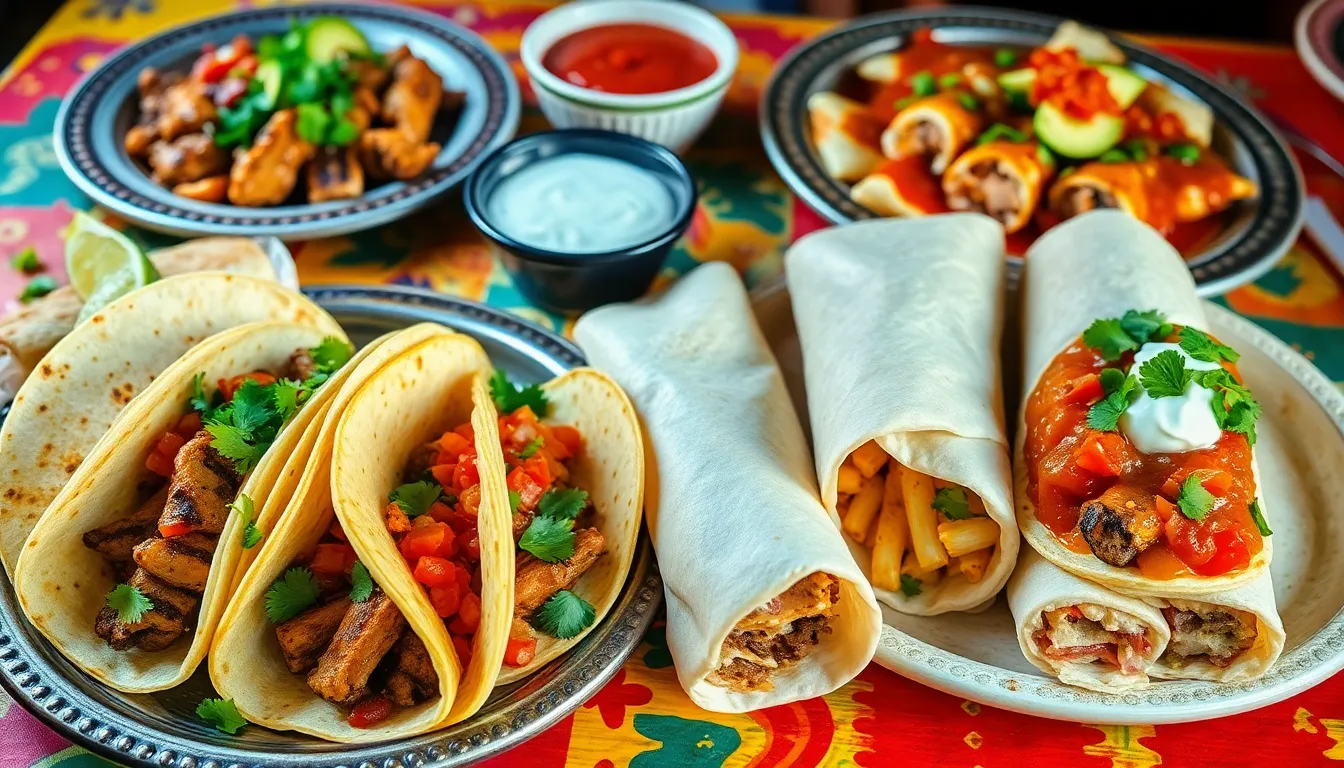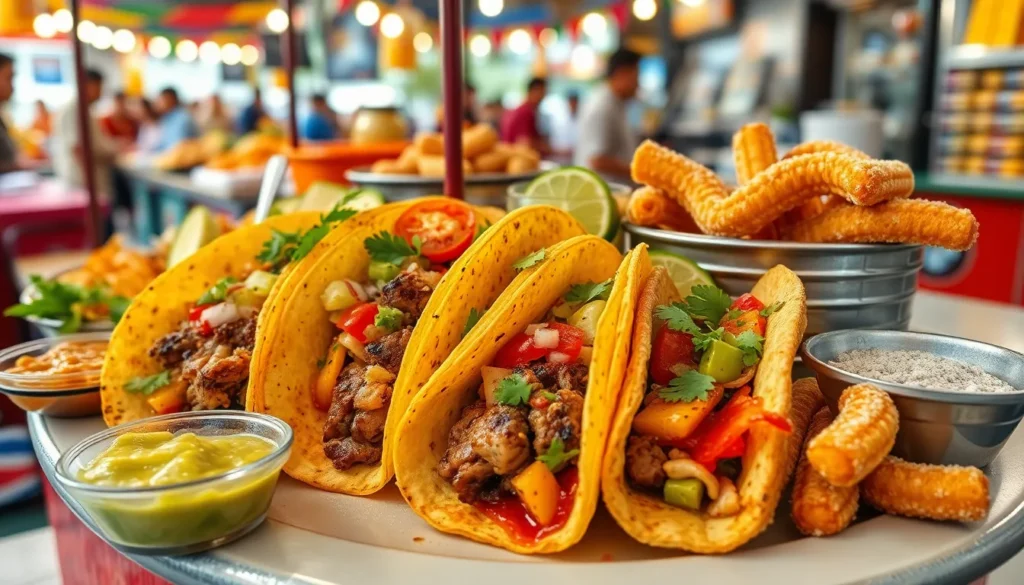Table of Contents
ToggleMexican food isn’t just a meal; it’s a fiesta for the senses! Picture vibrant colors, tantalizing aromas, and flavors that dance on the palate. From sizzling tacos to creamy guacamole, each dish tells a story. But let’s face it—sometimes it’s hard to keep track of what’s what when you’re staring at a plate that looks like a work of art.
Overview of Mexican Cuisine
Mexican cuisine offers a diverse array of flavors and traditions. Each region contributes unique ingredients and cooking techniques. Tacos, a staple, vary significantly. Soft corn tortillas filled with seasoned meats, vegetables, and salsas create endless variations.
Chiles play a crucial role, adding heat and depth to many dishes. They come in numerous varieties, including jalapeños, poblanos, and serranos. Enchiladas, another popular dish, consist of corn tortillas rolled around meat or cheese, smothered in sauce.
Salsas accompany most meals, crafted from fresh tomatoes, cilantro, and lime juice. They provide a vibrant kick that enhances the dining experience. Guacamole, made from ripe avocados, is both a dip and a condiment, enjoyed with chips or tacos.
Mexican desserts are equally enticing. Flan, a creamy custard, delights with its caramel topping. Churros, fried dough pastries, often served with chocolate sauce, are a favorite treat.
Street food also holds a significant place in the culture. Vendors sell an array of snacks such as elote (corn on the cob), tamales, and quesadillas. Each offering showcases the fresh, hearty ingredients that define this rich culinary tradition.
Festivals and gatherings highlight traditional recipes passed down through generations. Celebrations often feature dishes like mole, which combines chocolate and spices for a complex flavor. Every bite of Mexican cuisine tells a story, evoking the rich history and culture of the region.
Popular Mexican Dishes

Mexican cuisine features an exciting variety of dishes, each with distinct flavors and cultural significance. Several popular items highlight the country’s rich culinary heritage.
Tacos
Tacos stand as a quintessential Mexican dish. Corn tortillas serve as a base, often filled with options like grilled carne asada, tender chicken, and sautéed vegetables. Each taco showcases unique toppings, such as onions, cilantro, and fresh salsa. Variations abound, including soft or crispy shells, accommodating different preferences. Popular choices emphasize region-specific ingredients, enhancing the experience. In every bite, the combination of flavors and textures captures the essence of Mexican street food culture.
Enchiladas
Enchiladas represent another beloved dish. Typically, corn tortillas roll around fillings of meat, cheese, or beans, creating layers of goodness. A rich sauce smothers each one, with variations using red or green salsas for a distinct flavor profile. Garnishes like sour cream, avocado slices, and feta cheese elevate the dish further. Enchiladas reflect local traditions, with recipes varying from state to state. Every preparation offers a blend of spices that brings comfort and satisfaction.
Burritos
Burritos provide a hearty option in Mexican cuisine. Flour tortillas envelop generous fillings such as seasoned beef, chicken, beans, and rice. Cheddar cheese often melts into the mix, enhancing its richness. Burritos adapt to trends, incorporating diverse ingredients like grilled peppers and fresh guacamole. Each bite delivers substantial flavor, appealing to those who enjoy a satisfying meal. Many regions customize burrito recipes, contributing to their widespread popularity across the United States.
Visual Gallery of Mexican Food
This gallery showcases the stunning diversity of Mexican cuisine through vibrant images and names of traditional and modern dishes. Each food item represents a unique culinary story.
Pictures and Names of Traditional Dishes
Traditional dishes capture the heart of Mexican gastronomy. Tacos al pastor feature marinated pork, pineapple, and fresh cilantro, embodying city street flavors. Enchiladas verdes consist of rolled corn tortillas filled with chicken and topped with green tomatillo sauce. Mole poblano, a rich sauce made with chocolate, chiles, and spices, accompanies chicken or turkey. Tamales, made from masa and various fillings wrapped in corn husks, highlight regional ingredients. Chiles en nogada are stuffed poblano peppers topped with a creamy walnut sauce, showcasing seasonal produce. Each image provides a visual feast, drawing attention to the artistry of these classic recipes.
Pictures and Names of Modern Variations
Modern variations of Mexican cuisine attract food lovers with innovative twists. Gourmet tacos often feature fusion ingredients like Korean BBQ or grilled octopus, enhancing traditional flavors. Vegan enchiladas replace meat with mushrooms or jackfruit, catering to diverse diets. Burrito bowls give people customizable options with rice, beans, and fresh vegetables. Street-style nachos become sophisticated with artisan cheese and unique toppings. Desserts also evolve, with matcha churros or deconstructed flan gracing menus. These modern interpretations expand the palate while respecting traditional roots, creating a vibrant dining experience.
Cultural Significance of Mexican Food
Mexican food embodies rich cultural heritage and traditions, deeply rooted in history. Each dish reflects the unique influences of Indigenous, Spanish, and other immigrant cultures, showcasing a blend of techniques and ingredients. Traditional meals, like mole, symbolize regional specialties, combining various spices and chocolate for complex flavors.
Tacos serve as a universal symbol of Mexican cuisine, with countless regional variations representing local customs. Many families pass down recipes that define generations, preserving culinary techniques and ingredients. Influences from local agriculture create diverse offerings, ensuring distinct flavors across different states.
Celebrations and gatherings often revolve around food, where traditional dishes take center stage. Tamales frequently feature in festivities, representing ancestral recipes and the importance of community. Festivals, like Día de los Muertos, prominently showcase specific foods that honor loved ones, bringing people together through shared meals.
Street food plays a crucial role in daily life, highlighting the accessibility and creativity of Mexican cuisine. Elote stands on street corners symbolize casual dining, allowing people to enjoy quick, flavorful snacks. Beyond flavor, the vibrant colors and aromas of dishes create a sensory experience that captivates locals and tourists alike.
Culinary traditions also extend to beverages, such as aguas frescas and mezcal, which complement meals and reflect the region’s agricultural bounty. People often enjoy these drinks during gatherings, further enhancing the communal aspect of dining. Together, these elements weave a rich tapestry that captures the essence of Mexican culture, revealing stories behind every dish.
Mexican food is more than just a meal; it’s a celebration of culture and tradition. The vibrant colors and diverse flavors found in dishes like tacos and enchiladas invite everyone to explore a world of culinary artistry. Each dish tells a story that connects generations and regions, showcasing the rich heritage that influences every bite.
As food lovers continue to embrace both traditional and modern interpretations, Mexican cuisine remains a dynamic force in the culinary landscape. The stunning visuals accompanying these dishes not only tantalize the taste buds but also highlight the creativity and passion behind each recipe. Whether enjoyed at a street vendor or a gourmet restaurant, the essence of Mexican food continues to inspire and delight.




